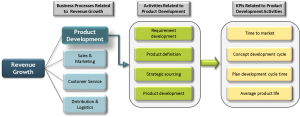Last Tuesday we posted the metric of the month (Revenue Growth this month). Today we’re going to take it one step further and talk about how Revenue Growth translates into – or “connects” -- to Time to Market – a common Key Performance Indicator (KPI) for goods and non-financial services companies….in other words, how you can actually talk to your client about impacting revenue growth through your solutions.
Said differently – This is the HOW to make the numbers make your job easier.
For illustrative purposes only, let’s review the case of an industrial company with $37B in revenue, based in the US. After conducting client research by reviewing the company’s annual report and investor presentations, we found the company had some very specific goals in terms of financial performance. Specifically, one of the company’s goals is to increase revenues by 3%-4%.
That means they are looking for between $1.1 and $1.5 billion in increased revenues. In addition, the company is very focused on innovation and new business opportunities. With this information on hand, HOW and HOW MUCH can your solution help them?
Exploring business processes is one way for you to get more specific about HOW you can help them achieve this goal. Let’s use the FinListics Business Process Maps to map revenue growth to the business processes that impact it and also to better understand the associated activities and key performance indicators (KPIs) that can be impacted by changes or improvements in a business process. Here we’re looking at the Business Process Map for Revenue Growth in the Industrial industry.
The map connects Revenue Growth to the Product Development process and shows time to market as one of the KPIs that can be impacted by changes in the product development process. (click on the graphic for a bigger view)  So when talking to this client who is focused on innovation and increasing revenues by 3% - 4%, one example of talking the HOW would be to show how your solutions can decrease time to market ….and HOW that will ultimately increase revenue.
So when talking to this client who is focused on innovation and increasing revenues by 3% - 4%, one example of talking the HOW would be to show how your solutions can decrease time to market ….and HOW that will ultimately increase revenue.
Operational KPIs In Action For this client with $37B in annual revenue, the industry average for time to market for new products is 210 days (trust us – this is our sweet spot). Your experience with other clients in this industry shows your solution can reduce this length of time by 5%-10% on an annual basis. Which means the improvement to annual revenue coming from the implementation of your solution is $282 - $565 million per year just in that one area with your solution! That’s the kind of talk that gets attention from client executives.
Not only that, but you can also point out that delaying the decision to implement, or dragging the decision out through a long RFP process, will represent between $2 million and $3 million per month in missing pretax cash flow improvement. Compelling stuff…..
The key to getting the above information? Asking questions:
- For your clients’ industries, what metrics, business processes and operational KPIs can your solutions significantly impact?
- What are industry norms for these operational KPIs?
- What ranges of improvement do your solutions provide for these KPIs and what is the cash flow value to your clients?
And of course – the most important question: How can you impact these areas and ultimately drive results for your client’s business?
For a deeper discussion on Operational KPIs and how they drive sales, see our previous blog post at www.finlistics.com/blog
